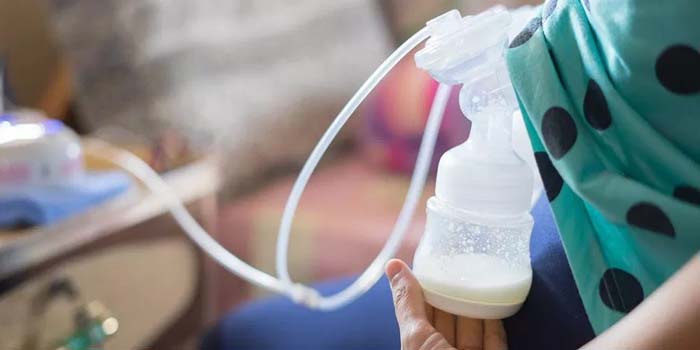Using manual breast pump allows to feed the child with breast milk when direct breastfeeding is impossible. Correct usage of the device can help to control lactation and minimize uncomfortable feelings for mom when pumping milk.
Which Breast Pump Is Better to Choose?
All devices on the market can be divided into two types:
- Manual and mechanical devices
- Electric
Their mode of action is similar. The difference is that mechanical ones are operated by hands, while electric ones work from mains. Choice of configuration, type or model depend on the woman’s financial abilities and personal demands.
Experience tells that electric device works much faster, so it is chosen for saving time, if there is a need to pump frequently. Manual breast pump comes handy on the road, it doesn’t depend on any source of energy. When purchasing, you should pay attention to the documents that prove the originality of the device, warranty sheet and complement.
Electric Breast Pump
Modern electric breast pumps can imitate the process of natural milk sucking by the baby. The majority of brands provide the ability to use breast pump both from mains and with batteries (accumulators). Electric motor that is attached to the cup or is connected to it with wires creates vacuum and regulates suction force and operation speed. Electric breast pump can pump milk twice as faster, and mom doesn’t have to invest any physical effort.
Manual Breast Pump
Manual breast pump is also called mechanical. The mode of action is based on the autonomous device control, so the intensity and quality of its work depend directly on the woman’s effort. With the right diligence and a few manual skills this device can become a useful helper in pumping breast milk. The disadvantages are time consuming pumping process and the necessity to invest physical effort. The advantages of mechanical devices are the following:
- Completely noiseless
- Don’t depend on electric power or batteries
- Easy to wash and sterilize
- Pumping process and its intensity are regulated by hand
According to CuteLittleDarling.com, there are a few types of manual breast pumps, i.e.:
Piston
Piston breast pump consists of a silicone nipple cap with an attached special lever and a bottle as a set. To pump you have to push the lever, firmly pressing the cap to the breast. Pumping is recommended no more than twice a day. This type of device works on the principle of vacuum milk outflow for the breast. Silicone cap is placed on the nipple, breast is supported by one hand and the other hand presses the lever rhythmically.
The negative point is that mother gets tired easily while pumping. Also users write about short life of the device’s details in the reviews.
Syringe
The device consists of two cylinders, where the inner one is applied on the nipple, and the outer makes back and forth movements. This type is the most popular, as it is small and easy to use. But it has its disadvantages: pumping goes slowly, mom gets tired quickly, device gets broken fast.
Pomp
Pomp breast pump is mostly designed for moms who don’t plan to pump regularly, but decided to purchase the device just in case. Its action is based on vacuum mechanism, which pumps milk. The cap of the device is applied on the areola, gets fixed on the breast and then the pomp is pressed frequently.
Despite the low cost and noiseless work, the device has some negative points:
- Not very comfortable
- No container for pumped milk
- Can traumatize the nipple
- Is not very effective
- Pumps low amount of milk
- Mom’s hands get tired quickly
- Not all parts can be fully sterilized
Bulb
It’s a plastic bottle with a bulb. Milk extraction from lacteal glands happens when the bulb is pressured manually. It is a bit inferior to the other types of breast pumps as milk is pumped very slowly and the process wears woman down a lot.
You May like to know : Breast Cancer: Most common signs and Symptoms
How to Assemble Breast Pump
No matter which breast pump you have purchased – electric or mechanical, before pumping milk you have to carefully read application sheet. It will help to avoid a number of mistakes that can cause device damage or lacteal glands trauma.
Before pumping, prepare a container for breast milk storage. It can be a sterilized bottle or other container.
After that prepare breast pump’s details. They should be also sterilized by boiling or steam cleaning in water bath. Then breast pump should be assembled according to the instructions.
How to Use Correctly
After you have prepared the device and cleaned your hands and breast, it’s time to start pumping. Sit in a comfortable position, relax and stay calm – comfort and good mood mean a lot in this process. Before the procedure you can take a warm shower and drink a cup of tea, it will ease pumping. If you have breast lumps or some uncomfortable feeling, lightly massage the problematic areas along mammillary ducts.
Breast pump is applied on the breast so that the nipple is in the center of a cap. It should firmly fit the breast, otherwise air will get in and vacuum will be created. From here on, everything depends on the type of device a woman is going to use.
Manual breast pump. Press a few times on the piston, changing the force and thus adjusting the breast pump to your own sensations.
Electric single-phase breast pump. Turn it on, choosing the lowest pumping force, and slowly increase the vacuum level to the most comfortable mode. Pump from 5 to 15 minutes, depending on the intensity of lactation.
Electric two-phase breast pump. Turn on the first phase that stimulates lactation, pump 2-3 minutes in that phase. The first phase imitates quick, but less intensive breast sucking by a baby. When you get the sensation of milk flow – turn on the second phase with high vacuum level.
If you start feeling discomfort during the process, breast aches, device doesn’t pump milk – it’s better to stop and lightly massage lacteal glands. After that repeat the process of imitative lactation. You have to know that the process shouldn’t give you painful sensations. In case of feeling pain again you should correctly adjust the device and try other comfortable position.
If you can’t get the milk flow going, check air-tightness between nipple and a cap. In case of air insertion breast pump won’t be able to work correctly.
How Often Should You Pump Milk
Woman should learn how to pump milk correctly in the first few days after giving birth. To get the right amount of milk you have to pump it by a schedule, not less than after every three hours, including pumping at nights. To increase the amount of milk, in case it got lower, you have to pump more frequently in the next few days – every two hours during daytime and every four hours at night.
For a relief in case of milk stasis, to drain milk in breast or in case of mastitis it is necessary to pump as often and as long as your condition requires. To prevent getting fissures it is recommended to pump foremilk or the last drops of milk after feeding the baby and rub it into the nipple.
Breast Pump Hygiene
Breast pump details should be sterilized. It is necessary as the device gets in contact with sterile breast milk. The device should be washed right after use to be prepared for the next pumping in time. All the details are thoroughly rinsed, put into a sterilizer or an ordinary saucepan with hot water. The details should stay in the hot water for about 10 minutes, after which they are taken out and dried.




